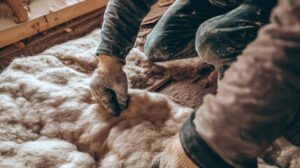Ceilings Perth are overhead surfaces that hide the underside of a floor or roof structure. They serve a number of functions such as acoustics, lighting and temperature control.

Ceilings can also add aesthetic appeal to a room and can be decorated in a variety of styles. Read on to learn more about the different types of ceilings available.
Tray ceilings are a popular architectural feature that adds dimension and visual interest to a room. Also known as recessed ceilings, they include a central section that is raised higher than the surrounding edges of the ceiling, creating a step or ledge in the shape of a tray. Whether installed in new construction or as a remodel project, this ceiling style can be used in a variety of rooms to create dramatic flair.
A key benefit of tray ceilings is that they help break up large rooms and prevent them from feeling cavernous. Because the central section is elevated, it can be used for a focal point like a chandelier or pendant light. In addition, a recessed ceiling can be used to install lighting fixtures and other design elements that would otherwise require too much headroom.
When installed in a home, tray ceilings can be used to separate living spaces, dining rooms and other gathering areas. They can also be used to highlight an area, such as a fireplace or kitchen island, within a room.
The ceiling design can be as simple or as elaborate as you want. For a more minimal look, homeowners can paint their ceilings a single color with the recessed sections painted a contrasting shade. They can also use wallpaper or stencils to create a ceiling mural or other decorative design.
For a more dramatic effect, homeowners can incorporate recessed lights and other ceiling accessories to make the space feel like it’s designed for entertaining or formal occasions. They can also install skylights to bring in natural light and blur the lines between indoors and out.
Beam Ceilings
Ceiling beams add a touch of character to any room. The exposed structural supports that were historically left uncovered are a staple of log home building, but can be used in many styles of homes. The design can be complicated because the joists and beams need to be structurally sound, but a skilled carpenter should be able to manage this project. If taking down ceiling drywall to expose ceiling joists isn’t an option, you can still achieve the look of exposed beams by using decorative faux beams.
These decorative supports are fabricated from a variety of materials, but most often are made of wood. They can be either painted or stained for an authentic look, or left natural to create a rustic feel. If you opt to use real wood, be prepared for regular upkeep as the exposed wood can be vulnerable to moisture and sunlight.
The best woods for a ceiling beam are hemlock, oak and hickory. They’re strong and can withstand the weight of a room without being too heavy, and they can be finished in a range of styles, from rough hewn to smooth. Douglas fir is also a good choice, and it’s easy to stain.
You can purchase faux wood beams, which are fabricated from polyurethane and molded fiberglass and are lighter in weight than solid wood. They’re available in a wide range of sizes and can be cut to fit the dimensions of your ceiling. They are a little more expensive than solid wood, but can be installed on a ceiling that might not support the weight of actual wooden beams.
You can also have a skilled artist paint 3D beams on your ceiling with a technique called trompe l’oeil, or “fool the eye,” to create a realistic effect. The technique is not for beginners, and requires a high level of artistic skill.
Coffered Ceilings
Known for their grid-like pattern of recessed panels, coffered ceilings add elegance and architectural interest to rooms. They’re also an effective way to boost light levels and create the illusion of greater height, making them a practical addition for any home improvement project. Whether you prefer a classic or modern design aesthetic, there are plenty of unique coffered ceiling ideas to suit your tastes and inspire your next home renovation.
Coffered ceilings, which feature beams that form a series of sunken “lacunae” (or panels) that create a coffer-like pattern on the ceiling, have long been an architectural design staple. They can bring a sense of sophistication and architectural grandeur to spaces, as well as elevate light levels, add warmth and visual interest and help disguise ceiling pipes and other structural components.
The panels can be designed in a variety of geometric shapes and sizes, adding another layer of design complexity to the ceiling. The coffers can be further embellished by decorative elements, such as crown molding and cornices or paneled wainscoting. The depth of the recessed panels can also be varied, from shallow to dramatic. Generally, it’s recommended that the depth of the coffers be larger than the width of the beams. This ensures that the overall effect is visually appealing and proportional.
Historically, coffered ceilings have been used in historic homes and buildings, including the Pantheon and Woolworth Building in New York City, but they are a popular option for contemporary spaces as well. They can be designed to complement or contrast the style of the room, with finishes ranging from rough-hewn woods and plasterwork to ornate moulding buildups. They’re often paired with a vaulted ceiling, which creates a sense of grandeur and adds a layer of visual texture.
Cathedral Ceilings
Cathedral ceilings are a unique architectural feature in homes. This slanted style of ceiling follows the slope of the roof to create a tall space with an open feel. They are often symmetrical but can be more creative in design. These soaring ceilings can add a dramatic flair to living spaces and are perfect for large rooms. They can make a living room, dining room or master bedroom feel expansive and luxurious. They can even mimic the feeling of a grand castle or church and bring an elevated sense of grandeur to a home.
One of the biggest advantages of a cathedral ceiling is that it can allow more natural light to enter the space, brightening up the room and making it look bigger. However, cathedral ceilings are not always energy efficient since hot air rises and can cause a loss of heat throughout the house. This can be a problem if the insulation in your roof system is not properly installed or maintained.
If you’re looking for ways to improve the performance of your cathedral ceiling, install proper insulation. This will help prevent the build-up of condensation and moisture damage.
If your cathedral ceiling is made of wood, consider painting it a neutral color to minimize the visual impact of the exposed beams. This will also help to keep the room feeling fresh and airy without overpowering your beautiful soaring structure. Alternatively, you can use a wood paneling that’s designed for ceilings to provide a more finished, elegant look for your space. This will also reduce the amount of maintenance your ceiling needs over time. If you’re interested in a more rustic appearance, you can also try refinishing the existing beams instead of painting them.
Arched Ceilings
Vaulted ceilings add a sense of openness and grandeur to a room, creating a soaring curved expanse overhead. They’re most often seen in churches, but are increasingly popular in residential architecture as well, offering a dramatic touch to rooms of all styles. There are several different types of vaulted ceilings, including barrel, groin, and dome ceilings. Each offers a distinct aesthetic.
A vaulted ceiling is characterized by self-supporting arches, which sit below a roof and above the walls. These arch-shaped ceilings are available in a variety of designs, and can be incorporated into homes ranging from modern to modern farmhouse to minimalist. They’re particularly attractive in great rooms and kitchen-living spaces, as their curved form can be augmented with reclaimed beams or industrial cable supports to enhance the design.
Barrel vaults, for example, feature a half-cylindrical design that adds a sense of elegance and openness to a space. They’re also a popular option for foyers, as they’re easy to install and require minimal roof modifications. Groin vaults, on the other hand, are more complicated. They’re formed by intersecting barrel vaults, and are typically associated with medieval-inspired decor and design.
A domed vaulted ceiling is another style of vaulted ceiling, which offers a spherical shape that creates a grand impression in a space. It’s also an excellent choice for cathedral-style homes, as it can add a sense of history and tradition. The biggest drawback of vaulted ceilings is that they’re more difficult to maintain than other types of ceilings, as their sloping structure makes it harder for homeowners to reach fixtures and paint. In addition, they may take longer to heat and cool, as air must circulate more slowly to reach comfortable temperatures.
